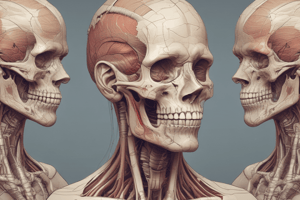Podcast
Questions and Answers
What is the primary component found in bone matrix?
What is the primary component found in bone matrix?
- Growth factors
- Proteoglycans
- Type I collagen (correct)
- Osteocalcin
What is the main function of bone in the body?
What is the main function of bone in the body?
It provides internal support of the body, attachment for muscles and tendons, encloses blood-forming elements, and protects vital organs.
Osteocytes are involved in maintaining the bony matrix and their death leads to matrix resorption.
Osteocytes are involved in maintaining the bony matrix and their death leads to matrix resorption.
True (A)
Osteoprogenitor cells are derived from ______ stem cells.
Osteoprogenitor cells are derived from ______ stem cells.
Match the following bone cells with their descriptions:
Match the following bone cells with their descriptions:
What is the primary bone tissue characterized by an irregular array of collagen fibers called?
What is the primary bone tissue characterized by an irregular array of collagen fibers called?
Which type of bone has dense areas generally without cavities?
Which type of bone has dense areas generally without cavities?
What is the bulbous ends of long bones composed of spongy bone covered by a thin layer of compact bone called? Epiphyses- the _______
What is the bulbous ends of long bones composed of spongy bone covered by a thin layer of compact bone called? Epiphyses- the _______
Vitamin D deficiency leads to a condition known as osteomalacia.
Vitamin D deficiency leads to a condition known as osteomalacia.
Match the following bone repair steps in order:
Match the following bone repair steps in order:
Flashcards are hidden until you start studying
Study Notes
Here are the study notes for the text:
Bone Structure and Function
- Bone provides internal support, attachment for muscles and tendons, and encloses blood-forming elements of the bone marrow and vital organs of the cranial and thoracic cavities.
- Bone is a connective tissue characterized by a mineralized extracellular matrix, producing a hard tissue capable of providing support and protection.
- Bone matrix contains mainly type I collagen, along with other matrix proteins and traces of type IV, III, XI, and XIII collagens.
- Four main groups of non-collagenous proteins found in the bone matrix:
- Proteoglycans (contribute to compressive strength, bind growth factors, and inhibit mineralization)
- Multiadhesive glycoproteins (e.g. osteonectin, osteopontin, sialoprotein I and II)
- Bone-specific, vitamin K-dependent proteins (e.g. osteocalcin, protein S, matrix Gla-protein)
- Growth factors and cytokines (e.g. insulin-like growth factors, tumor necrosis factor, transforming growth factor, platelet-derived growth factors, bone morphogenic proteins, interleukins)
Bone Cells
- Osteoprogenitor cells: derived from mesenchymal stem cells, give rise to osteoblasts, and are found on external and internal surfaces of bones.
- Osteoblasts:
- Synthesize organic components of bone matrix
- Polarized cells, secreting matrix components at the bone surface
- Can become osteocytes or bone-lining cells
- Osteocytes:
- Enclosed in lacunae, connected by canaliculi
- Involved in maintaining bone matrix
- Can become quiescent, formative, or resorptive osteocytes
- Osteoclasts:
- Large, motile cells with multiple nuclei
- Resorb bone matrix, lying in enzymatically etched depressions (resorption bays)
Bone Matrix
- Inorganic material (50% of dry weight):
- Hydroxyapatite
- Bicarbonate
- Citrate
- Magnesium
- Potassium
- Sodium
- Amorphous calcium phosphate
- Organic matter:
- Type I collagen
- Ground substance (proteoglycan aggregates, multiadhesive glycoproteins)
- Calcium-binding glycoproteins (e.g. osteocalcin)
- Phosphatases
Periosteum and Endosteum
- Periosteum:
- Dense fibrous outer layer
- Osteoprogenitor cells found in the innermost cellular layer
- Provides nutrition, repair, and growth of bone
- Endosteum:
- Thin, single layer of connective tissue
- Covers small spicules or trabeculae of bone
- Lines internal marrow cavities
Types of Bone
- Compact bone:
- Dense, with no cavities
- Covers external surfaces of bone
- Cancellous (spongy) bone:
- Areas with numerous interconnecting cavities
- Found in the ends of long bones, and in the interior of short bones
Osteogenesis
- Intramembranous ossification:
- Osteoblasts differentiate directly from mesenchyme
- Primary bone tissue appears first
- Endochondral ossification:
- Matrix of preexisting hyaline cartilage is eroded and replaced by osteoblasts
- Both processes produce primary bone tissue
Histophysiology of Bone
- Vitamin D deficiency:
- Rickets in children
- Osteomalacia in adults
- Impaired calcium absorption and bone calcification
- Vitamin C deficiency:
- Impaired collagen production and maintenance
- Delayed healing of fractures
- Vitamin A deficiency:
- Impaired skeletal growth and bone remodeling
- Increased bone resorption
Hormones Influencing Bone Growth and Maintenance
- Parathyroid hormone (PTH):
- Regulates bone resorption and calcium release
- Acts on the kidney to increase calcium reabsorption
- Balances calcium levels in the blood
- Calcitonin:
- Inhibits bone resorption
- Lowers calcium levels in the blood
- Produced in response to hypercalcemia
- Growth hormone:
- Essential for normal bone growth
- Excess or deficiency leads to abnormalities
- Sex hormones (gonads):
- Affect skeletal maturation and closure of epiphyseal ossification centers
- Influence bone growth and development
Bone Repair
- Fracture repair:
- Hemorrhage and clotting
- Formation of granulation tissue (procallus)
- Transformation to cartilage (temporary callus)
- Remodeling of bone
Joints
- Diarthroses:
- Joints that permit free bone movement
- Have a synovial cavity lined by a synovial membrane
- Contain synovial fluid
- Synarthroses:
- Joints that have very limited or no movement
- Unite bones using bone, cartilage, or fibrous tissue
- Components of a diarthrosis:
- A capsule continuous with a covering ligament
- A synovial or joint cavity lined by a synovial membrane
- Synovial fluid
Studying That Suits You
Use AI to generate personalized quizzes and flashcards to suit your learning preferences.




